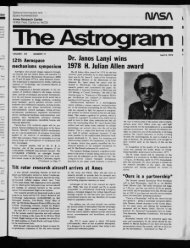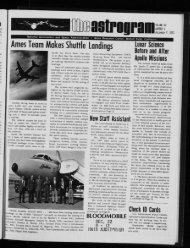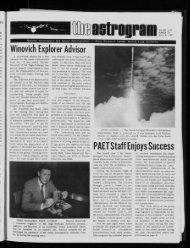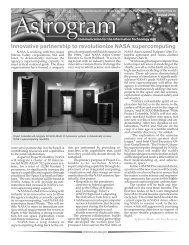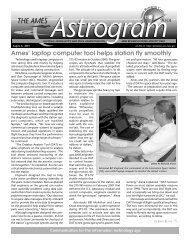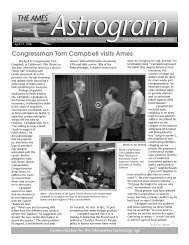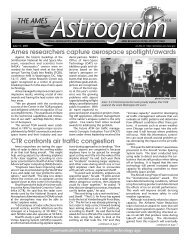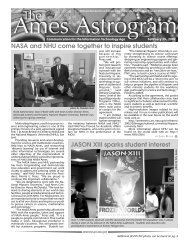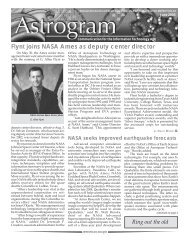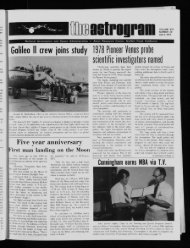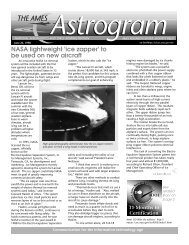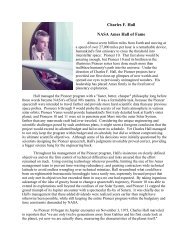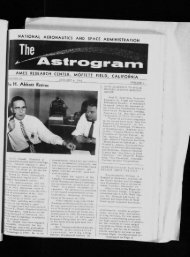3/12/01 Astrogram - NASA Ames History Office
3/12/01 Astrogram - NASA Ames History Office
3/12/01 Astrogram - NASA Ames History Office
Create successful ePaper yourself
Turn your PDF publications into a flip-book with our unique Google optimized e-Paper software.
Science & Research<br />
<strong>Ames</strong> sends first hardware to<br />
International Space Station<br />
<strong>Ames</strong> sent its first space hardware to the<br />
International Space Station (ISS) on the<br />
Space Shuttle Discovery in early March.<br />
The passive dosimeter system (PDS) will<br />
The electronic reader (shown above) that<br />
measures accumulated radiation dose in a<br />
termoluminescent detector. The Hungarian<br />
Space <strong>Office</strong> provided the reader to <strong>NASA</strong>.<br />
serve as a flexible and easy-to-use radiation<br />
monitor available for use by any researcher.<br />
It also will serve as a useful complement to<br />
existing dosimetry used for routine ISS operations.<br />
The hardware consists of two kinds<br />
of radiation detectors (dosimeters) and an<br />
electronic “reader.” The dosimeters can be<br />
placed anywhere in the ISS to provide an<br />
accurate measurement of the radiation at<br />
their locations.<br />
“Monitoring radiation exposure is important<br />
both to crew health and to future<br />
scientific research on the ISS,” said PDS<br />
payload manager Robert Jackson of <strong>Ames</strong><br />
Code SFE. “These dosimeters can stay on<br />
the station indefinitely, and they will be<br />
available to scientists in a variety of fields,”<br />
he continued.<br />
Understanding the radiation environment<br />
on the ISS will help scientists explain<br />
experimental results that otherwise might<br />
be unaccounted for. The radiation measurements<br />
can help scientists determine<br />
whether a given effect is due to microgravity,<br />
radiation or something else. The PDS will be<br />
part of <strong>NASA</strong>’s laboratory support equipment<br />
and will be available to all ISS partners’<br />
life science investigators.<br />
One type of radiation dosimeter is a<br />
thermoluminescent detector or TLD. Each<br />
TLD, which resembles a fat fountain pen,<br />
contains calcium sulfate crystals inside an<br />
evacuated glass bulb. These crystals absorb<br />
energy from incident ionizing radiation (protons,<br />
neutrons, electrons, heavy charged<br />
particles, gamma rays and x-rays) as the<br />
radiation passes through them. This process<br />
results in a steady increase in the energy<br />
level of the electrons in the crystal.<br />
To read the accumulated radiation dose,<br />
an astronaut aboard the ISS removes the<br />
crystal-containing dosimeter from its mea-<br />
surement location and places it<br />
into the electronic reader. A<br />
component inside the reader<br />
heats the crystals. As they are<br />
heated, the crystals emit a glow<br />
of light proportional to the<br />
amount of radiation to which<br />
they were exposed. A photomultiplier<br />
tube in the reader<br />
measures this glow. The reader<br />
stores the measured dose on a<br />
memory card that can be returned<br />
to Earth for further analysis.<br />
After the crystals have emitted<br />
all the stored energy, they are ready to<br />
begin accumulating another dose and the<br />
TLD is ready to be reused.<br />
The other dosimeters are plastic nuclear<br />
track detectors (PNTDs) — thin sheets of<br />
plastic similar to the material used for some<br />
eyeglass lenses. As heavy charged ions pass<br />
through the PNTDs, the surface becomes<br />
pitted with tiny craters. After the detectors<br />
are returned to Earth, the plastic is etched<br />
to enlarge the craters, which are counted<br />
and their shapes and sizes are analyzed<br />
using a microscope. This information is<br />
used to improve the accuracy of the radiation<br />
dose the TLDs have recorded and to<br />
improve the estimate of the biological effects<br />
of the radiation.<br />
STS-102, which launched March 8<br />
launch, carried the complete set of 48 TLDs<br />
and the reader to the ISS, where they will<br />
remain indefinitely to support a variety of<br />
future scientific experiments. A set of <strong>12</strong><br />
PNTDs will be carried to the ISS on STS-100<br />
later this year. The combined dosimeters<br />
will be used to measure radiation as part of<br />
the DOSMAP experiment, which is being<br />
conducted by the <strong>NASA</strong> Human Research<br />
Thermoluminescent radition detector is shown in a PNTD<br />
holder that allows it to be placed in different locations<br />
inside the International Space Station.<br />
Facility on the ISS. The exposed PNTDs will<br />
be returned to Earth by the STS-105 mission<br />
for later analysis.<br />
The Hungarian Space <strong>Office</strong> provided<br />
the thermoluminescent detectors, which<br />
are a third-generation version of dosimeters<br />
that flew on the Russian space stations<br />
Salyut 7 and Mir, and on the space shuttle.<br />
The Hungarian Space <strong>Office</strong> also provided<br />
the compact radiation reader, which is<br />
smaller than a typical shoebox. The PNTDs<br />
are provided and analyzed by ERIL Research<br />
Company, San Rafael, CA.<br />
<strong>Ames</strong> has led efforts to verify and certify<br />
the dosimeters for safety, and to package<br />
them in one of four transport containers,<br />
which resemble insulated lunch bags. One<br />
container holds a reader and <strong>12</strong> TLDs with<br />
associated power and data cables. Two<br />
additional kits each hold 18 TLDs. The final<br />
kit holds <strong>12</strong> PNTDs and 2 memory cards for<br />
the reader.<br />
“This is just the first step in a series of<br />
hardware <strong>Ames</strong> will be sending to ISS to<br />
support fundamental biology research,”<br />
Jackson said.<br />
Shih receives service award<br />
BY ANN HUTCHISON<br />
On Feb.16, John McGraw of the Federal Aviation Administration (FAA), who led the 737<br />
flight controls engineering test and evaluation board, presented an award to K.C. Shih<br />
(<strong>Ames</strong> Code ARH) for his service as chairperson of the challenge team.<br />
2 — The <strong>Ames</strong> <strong>Astrogram</strong> March <strong>12</strong>, 20<strong>01</strong><br />
photo by Dominic Hart



